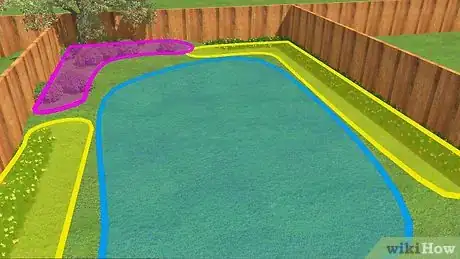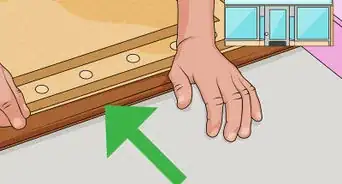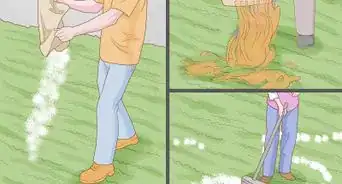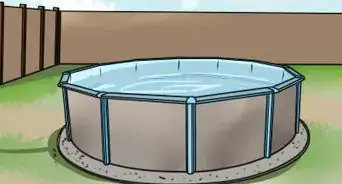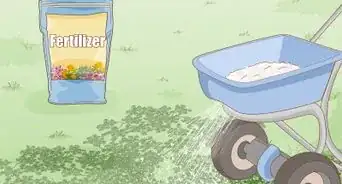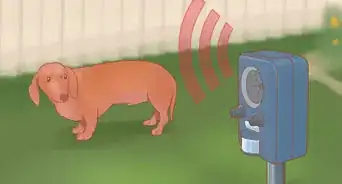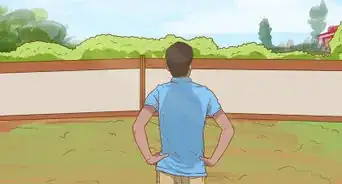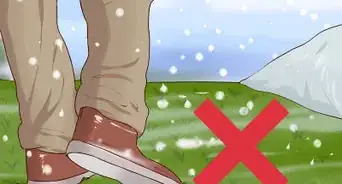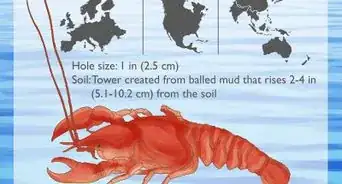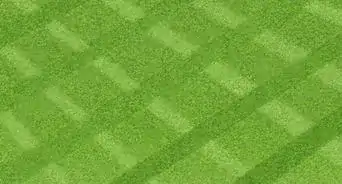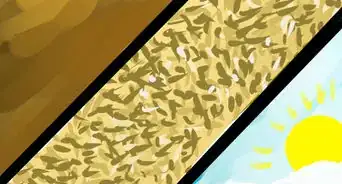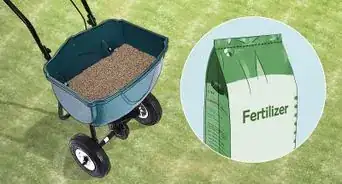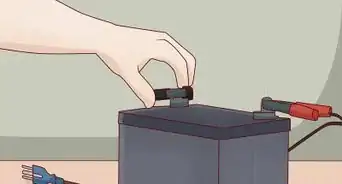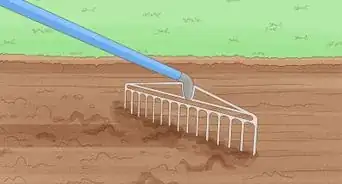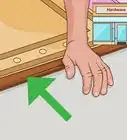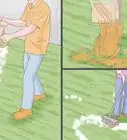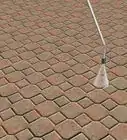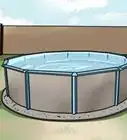This article was co-authored by Benjamin Hansen. Benjamin Hansen is a Landscape Contractor and the Owner of Artscape Gardens, a boutique landscaping company in Los Angeles, California. With over 12 years of experience, Benjamin specializes in transforming properties into aesthetic, functional, and drought-tolerant oases. Benjamin uses color scheme, dimension, and water conscious spaces to inspire the design and installation of soft scape, hardscape, patios, pathways, irrigation, drainage, fencing, concrete, lighting, and electrical work. Artscape Gardens covers all areas of the C-27 landscape contractor classification.
There are 11 references cited in this article, which can be found at the bottom of the page.
wikiHow marks an article as reader-approved once it receives enough positive feedback. In this case, several readers have written to tell us that this article was helpful to them, earning it our reader-approved status.
This article has been viewed 403,264 times.
With proper installation, an artificial lawn requires no regular maintenance apart from an occasional spray to keep it clean.[1] The installation itself can be intense, especially for a large lawn, so recruit a few strong friends to help with the process.
Steps
Preparing the Area
-
1Spray the areas with a weed killer. For any existing vegetation (grass and weeds) in the area where you want to lay your turf, start by spraying with Round-Up or a similar product to kill all of the vegetation in the area. Do this at least two weeks before you start your project to give it time to work and kill off all of the vegetation in the area. This will help to ensure that all of the plant material is dead down to the roots.
-
2Remove the top level of soil. If installing the lawn over soil, dig up the top 3 or 4 inches (7.5–10 centimeters) of sod to make room for the new base.[2] You can use a small rototiller to help you dig up the lawn and break up the soil. Remove all existing grass and other plants, or they may create an uneven surface after they die.[3]
- Let rain-soaked soil dry for a few days before you excavate, to prevent slumping.[4]
- While the remaining surface doesn't need to be perfectly graded, walk over it or use a hand tamp to compact any obviously loose soil. A slight slope is recommended to improve drainage.
Advertisement -
3Plan your drainage. Installations over well-draining soil should have few issues with drainage, as the artificial grass should be permeable to water, and the aggregate base described below provides an additional drainage layer. If you are installing the lawn over poorly-draining soil or a hard surface such as concrete, take the following precautions:
- If there is no drain near the lawn, install a drainage system before you continue.
- If your area only experiences light rainfall, it may be enough to leave small drainage gaps every 6" (15 cm) around the perimeter.[5]
-
4Install a border. Install a waterproof border along the perimeter if one is not already present, in order to keep the lawn from slumping or separating over time. A plastic bender board is a common, effective option.
- If you're interested in a more involved overhaul, you can pour a concrete curb around the area instead.
- Make sure the border won't protrude above the grass level, or it may inhibit drainage.
-
5Add a weed barrier (optional). If you are concerned about weeds growing through your artificial grass, lay out a geotextile barrier at the bottom of the excavated area.[6] This may also help deter gophers and earthworms from digging through your synthetic turf.
- Keep in mind that a geotextile barrier is a tightly woven, fairly heavy weed blocker. You can purchase one from an artificial turf supplier, at a true nursery or garden center, or from a landscape and irrigation supply business. A geotextile barrier is not the same thing as a weed blocker that you might buy from a home improvement store.
- You may install this over the base material instead.
- If you have a major rodent issue, consider a layer of rodent wire as well.
- Contact a professional rodent and pest control business for help to remove rodents. If left alone, rodents will wreak havoc on your artificial lawn.
Installing the Base
-
1Add the base material.[7] Purchase finely crushed rock, gravel, or decomposed granite, with particles under ⅜" (10 mm). Fill the excavated area with about three to four inches (7.5–10 cm) of this material to prevent slumping and improve drainage.
- You'll need approximately one cubic yard of material for every 100 square feet of lawn (0.82 cubic meters per 10 square meters).[8] The information available for your specific product may provide a more accurate coverage estimate.
- If installing the lawn over concrete or another hard surface, a rubber shock pad or self-leveling compound can work instead.[9] [10] Alternatively, you can skip this step if you are certain the concrete has adequate slope for drainage and that you can completely cover the edge of the slab with the artificial grass.
- If children will be playing on the artificial lawn, then you may want to go with a shock pad for safety reasons.
-
2Grade the base. Use a landscaping rake to smooth out the base material. Use a bubble level, string, and ruler to grade flat surfaces to a 2–3% slope (a 2–3 foot drop per 100 feet), sloping down to the drainage system or curb.[11]
-
3Moisten and compact the base. Sprinkle the gravel or sand lightly with a garden hose (be sure not to over water) to lubricate the particles in preparation for compaction. Use a plate compactor, roller compactor, or hand tamp to compact the material into a sturdy base, reducing it to 90% or less of its original depth (a drop of about 0.3 inches / 7.5 mm).[12] This will likely require several passes back and forth over the area. Go in different, overlapping directions on each pass for best compaction results.
- A vibratory plate compactor is the most effective option for this purpose.[13]
- These tools are available from tool rental services. The hand tamp is the cheapest to purchase permanently.
-
4Roll out the lawn on the side while the base dries. Unroll the artificial turf somewhere to the side, as it may take a couple of hours to recover its shape after being transported in rolls. Wait until the base dries, then make sure it is smooth and firm before you continue.
- If the base is not smooth, it needs more compaction.
- If the base ended up lower than expected, you may need to pour in and compact an additional layer, to ensure a fairly flat join between the artificial turf and surrounding surfaces.
Installing the Lawn
-
1Lay out the turf. Measure the area where the lawn will be laid out, and the width and length of the turf strips. With a partner, stretch out each strip of turf and lay it down over the prepared base. Avoid dragging the lawn over the base, or you may disturb the smooth surface.[14]
- In most artificial turf, the fake grass blades bend in one direction. Make sure all the turf is installed with the blades in the same direction, or your grass will look less natural.
-
2Cut the turf where necessary. Use a carpet cutter or utility knife to cut the underside of the turf whenever required by the shape of the project area.[15]
- When making long cuts, cut short distances at a time and compare to the edge to make sure there are no significant gaps. Drawing the cut line onto the back with a marker may also help.
-
3Get a carpet stretcher (optional). For best results, use a carpet stretcher to stretch the turf strips just before you seam or fasten them, as described below. Press the stretcher flat against the turf with the bristles facing down, and kick the padded end firmly with your knee. Stretching the turf eliminates wrinkles, reduces expansion from heat, and helps secure the surface tightly to the ground.[16]
- This tool is also called a carpet kicker.
-
4Seam the turf strips together. There are several ways to join two strips of synthetic turf. A product made by the same company that sold your turf may provide the best results since it will be designed for use on your lawn. Here are the most common options:
- Line up the two strips close together, then fold the edges back and lay artificial lawn seaming material on the exposed base. Cover the seaming material with the accompanying adhesive product, then fold the strips back over the seaming material and let dry.[17] Use the manufacturer's recommended adhesive only.
- Or lay a length of seaming tape or strong outdoor tape on the ground and place the two strips on top of it.[18]
- Or fasten together with stakes, approximately one every three inches (7.5 cm).
-
5Fasten the turf perimeter. Use 4–6 inch (10.2–15.2 cm) galvanized stakes or landscaping anchor pins to fasten the turf around the perimeter, at 6 inch (15 cm) intervals. Hammer them flat, but avoid excessive hammering, which can cause dips in the lawn.[19]
- For maximum strength, offset the stakes on opposite sides, rather than using two lines of stakes exactly opposite each other.[20]
-
6Add infill or ballast appropriate to your product. Most artificial turf requires added particles to keep the bristles standing, weigh the grass down, and provide cushioning for athletic activities. While the lawn is completely dry, apply a thin layer of one of these materials, by hand or using a drop spreader. Rake in each layer to smooth it out. Repeat until approximately half the blade length is covered.[21] For best results, use the material and amount of material specified by your product's manufacturers. These are the most common options:
- Washed silica sand is used primarily as ballast to weigh the turf down. If your turf requires infill, sand alone may not be enough.
- Black crumb rubber provides the most cushioning and support for the grass blades. They may make a mess if the lawn is installed on a slope, or if pets use the lawn as a toilet.
- Copper slag absorbs odors from pets better than other options.[22]
- Some dense products do not require infill. Some professionals prefer to add infill anyway for strength, although this is a somewhat controversial topic.
-
7Brush the turf in between infill applications. After each raking of infill material, use a power broom to "bloom" your turf, brushing up the grass blades. If you cannot find a power broom, use a stiff nylon-bristled broom or carpet rake.
-
8Water the lawn. This will help the infill or ballast settle. Check the material the next day to see the final result. If the lawn isn't bouncy enough or too much of each grass blade is exposed, rake in another layer of infill.[23]
- Optionally, use a leaf-blower to clear debris from the surface once finished.
Expert Q&A
Did you know you can get expert answers for this article?
Unlock expert answers by supporting wikiHow
-
QuestionHow do I prepare soil if I want to overseed a lawn?
 Jeremy YamaguchiJeremy Yamaguchi is a Lawn Care Specialist and the Founder/CEO of Lawn Love, a digital marketplace for lawn care and gardening services. Jeremy provides instant satellite quotes and can coordinate service from a smartphone or web browser. The company has raised funding from notable investors like Y Combinator, Joe Montana, Alexis Ohanian, Barbara Corcoran and others.
Jeremy YamaguchiJeremy Yamaguchi is a Lawn Care Specialist and the Founder/CEO of Lawn Love, a digital marketplace for lawn care and gardening services. Jeremy provides instant satellite quotes and can coordinate service from a smartphone or web browser. The company has raised funding from notable investors like Y Combinator, Joe Montana, Alexis Ohanian, Barbara Corcoran and others.
Lawn Care Specialist
-
QuestionShould artificial turf be laid in a certain direction?
 Anthony "TC" WilliamsAnthony "TC" Williams is a Professional Landscaper in Idaho. He is the President and Founder of Aqua Conservation Landscape & Irrigation, an Idaho Registered Landscape Business Entity. With over 21 years of landscaping experience, TC has worked on projects such as the Idaho Botanical Garden in Boise, Idaho. He is a Idaho Registered Contractor and a previously Licensed Irrigator in the State of Texas.
Anthony "TC" WilliamsAnthony "TC" Williams is a Professional Landscaper in Idaho. He is the President and Founder of Aqua Conservation Landscape & Irrigation, an Idaho Registered Landscape Business Entity. With over 21 years of landscaping experience, TC has worked on projects such as the Idaho Botanical Garden in Boise, Idaho. He is a Idaho Registered Contractor and a previously Licensed Irrigator in the State of Texas.
Experienced Landscaper
-
QuestionWhat size nails do you use to hold turf down?
 Anthony "TC" WilliamsAnthony "TC" Williams is a Professional Landscaper in Idaho. He is the President and Founder of Aqua Conservation Landscape & Irrigation, an Idaho Registered Landscape Business Entity. With over 21 years of landscaping experience, TC has worked on projects such as the Idaho Botanical Garden in Boise, Idaho. He is a Idaho Registered Contractor and a previously Licensed Irrigator in the State of Texas.
Anthony "TC" WilliamsAnthony "TC" Williams is a Professional Landscaper in Idaho. He is the President and Founder of Aqua Conservation Landscape & Irrigation, an Idaho Registered Landscape Business Entity. With over 21 years of landscaping experience, TC has worked on projects such as the Idaho Botanical Garden in Boise, Idaho. He is a Idaho Registered Contractor and a previously Licensed Irrigator in the State of Texas.
Experienced Landscaper
Things You'll Need
- Gravel, crushed rock, sand, or aggregate
- Shovel
- Landscaping rake
- Garden hose
- Plate compactor, roller compactor, or hand tamp (available from tool rental services)
- Artificial turf
- Seaming sheets, seaming tape, and/or outdoor glue
- Galvanized nails or landscaping anchor pins
- Plastic bender board (unless a border already exists)
- Turf infill or ballast
- Power broom or stiff nylon broom
- Carpet stretcher (recommended)
- Rodent wire (if necessary)
- Weed barrier (optional)
- Transit and rod or string line
- Line level
Warnings
- Take care not to damage any irrigation lines while excavating for the artificial lawn. If using drip irrigation lines, use an irrigation plug or clamp to shut off water along the length of the artificial lawn.⧼thumbs_response⧽
- Keep the lawn away from barbecues, cigarettes, and other heat sources, or the plastic may melt.⧼thumbs_response⧽
- Chlorine from swimming pools may discolor your artificial lawn. You may not want to install the lawn within three feet (0.9 meters), in order to avoid this.⧼thumbs_response⧽
References
- ↑ Benjamin Hansen. Licensed Landscape Contractor. Expert Interview. 6 October 2020.
- ↑ Benjamin Hansen. Licensed Landscape Contractor. Expert Interview. 6 October 2020.
- ↑ http://www.artificial-grass.com/Frequently-asked-questions.php
- ↑ http://www.easyturf.com/artificial-grass-turf-customer-service/how-to-install-artificial-grass/
- ↑ http://d11fdyfhxcs9cr.cloudfront.net/templates/185330/myimages/plastic_grass__claremont_0800_644_1964.pdf
- ↑ Benjamin Hansen. Licensed Landscape Contractor. Expert Interview. 6 October 2020.
- ↑ Benjamin Hansen. Licensed Landscape Contractor. Expert Interview. 6 October 2020.
- ↑ http://www.easyturf.com/artificial-grass-turf-customer-service/how-to-install-artificial-grass/
- ↑ http://www.artificial-grass.com/Frequently-asked-questions.php
- ↑ http://www.artificial-grass.com/permanent_base.htm
- ↑ http://grounds-mag.com/drainage/surface_water_drainage/
- ↑ http://www.easyturf.com/artificial-grass-turf-customer-service/how-to-install-artificial-grass/
- ↑ http://www.qrents.com/docs/compaction.htm
- ↑ http://www.easyturf.com/artificial-grass-turf-customer-service/how-to-install-artificial-grass/
- ↑ http://www.easyturf.com/artificial-grass-turf-customer-service/how-to-install-artificial-grass/
- ↑ http://www.globalsynturf.com/installation/
- ↑ http://www.easyturf.com/artificial-grass-turf-customer-service/how-to-install-artificial-grass/
- ↑ http://www.rcpblock.com/installation-artificialturf.html
- ↑ http://www.rcpblock.com/installation-artificialturf.html
- ↑ http://www.easyturf.com/artificial-grass-turf-customer-service/how-to-install-artificial-grass/
- ↑ http://www.easyturf.com/artificial-grass-turf-customer-service/how-to-install-artificial-grass/
- ↑ http://www.angieslist.com/articles/ask-angie-pet-friendly-advice-artificial-turf.htm
- ↑ Jeremy Yamaguchi. Lawn Care Specialist. Expert Interview. 21 January 2019.
About This Article
Before installing an artificial lawn, prepare the area by killing any weeds or vegetation and adding a base of 4 inches of compacted gravel so the turf will lay flat. Next, stretch out the strips of turf across the area and use a utility knife to trim it where necessary. Then, fasten the turf down at the edges with landscaping anchor pins every 6 inches. Finally, add the recommended filler to keep your turf weighed down and use a rake to spread it out evenly. For tips from our Landscaping reviewer on how to join two strips of turf without creating a noticeable seam, read on!

